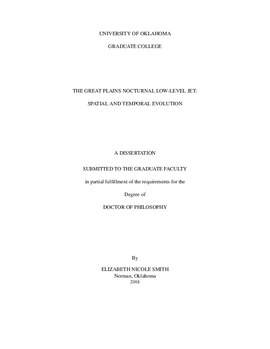| dc.description.abstract | The nocturnal low-level jet (NLLJ) is a maximum in the vertical wind profile often occurring in the lowest 1-km of the atmosphere during the overnight hours in the Great Plains of the United States. This wind maximum has many implications including wind energy impacts, aviation hazards, and convection and precipitation forecasting. In broad terms, this dissertation set out to expand the current understanding of the mechanisms that lead to the development of NLLJs in the Great Plains. Using high resolution observations and numerical simulations together, this dissertation documents, describes, and analyzes spatial and temporal characteristics of the Great Plains nocturnal low-level jet.
The first part of the dissertation focuses on identifying the optimal configuration in which to run the Weather Research and Forecasting (WRF) model for NLLJ studies. Horizontal spacing finer than 4-km did not offer enough improvement to the resulting simulation to justify computational expense. Using finer vertical spacing did improve simulations of NLLJs. Sensitivity to planetary boundary layer parameterization scheme was generally small. Based on the conducted sensitivity tests, the optimal WRF model configuration for NLLJ studies was identified as based on a grid with 4-km horizontal spacing, 40-m vertical constant spacing, and employing the Quasi-Normal Scale Elimination planetary boundary layer parameterization scheme.
Next, data were collected during three Plains Elevated Convection at Night (PECAN) field campaign NLLJ cases and used alongside optimally configured simulations to identify and describe the spatial and temporal characteristics of Great Plains NLLJs. This analysis showed that the NLLJ is heterogeneous with respect to depth, wind speed, and wind direction. Additionally, the spatially heterogeneous NLLJ was shown to be moving across the slope of the Great Plains through the night. As such, the spatial and temporal characteristics of the nocturnal low-level jet are inherently connected and should not be considered independently.
This spatial-temporal evolution of the NLLJ has multiple implications for our understanding of local NLLJ features. The typical spatial and temporal evolution of the NLLJ was described using PECAN observed cases. A set of fourteen cases (including both PECAN and Lower Atmospheric Boundary Layer Experiment, LABLE, cases) were used to document and describe features of this evolution. Two buoyancy-related driving mechanisms were investigated to explain the spatial-temporal variability of the NLLJ. The consideration of this motion and spatial heterogeneity showed that sudden changes in the nocturnal boundary layer structure could be induced by the advection of spatial jet characteristics. | en_US |
